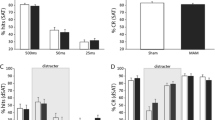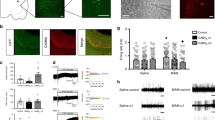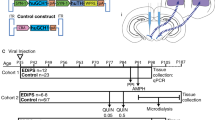Abstract
Studies into the pathophysiology of schizophrenia have consistently demonstrated a dysfunction of dopamine (DA) system regulation in this disorder. This includes hyper-responsivity to DA agonists, the therapeutic efficacy of DA antagonists, and augmented striatal DA release in response to amphetamine. Nonetheless, there is little evidence for a pathological alteration with the DA system itself in schizophrenia. Instead, it is suggested that the disturbance lies in the manner by which the DA system is regulated. Recently, rodent models of schizophrenia have been advanced based on developmental disruption that recapitulates many of the symptoms observed in human schizophrenia patients. We found that administration of the mitotoxin methylazoxymethanol acetate (MAM) to rats at gestational day 17 leads to adult rats that exhibit neuroanatomical, pharmacological, and behavioral characteristics consistent with schizophrenia. These rats also exhibit hyperactivity within the ventral subiculum of the hippocampus that corresponds to a loss of parvalbumin-containing interneurons. This hyperactivity causes an increase in the population activity of the DA neurons(i.e., more DA neurons are firing spontaneously), thus increasing the responsivity of the DA system to stimuli. When the ventral subiculum is inactivated, DA neuron population activity is restored to baseline, and the hyperresponsivity to amphetamine is normalized to that observed in control rats. These findings demonstrate a direct link between the hippocampal pathophysiology, interneuronal alterations, and hyperdopaminergic state observed in the schizophrenia patient. Moreover, this suggests an alternate pharmacotherapeutic approach based on the normalization of hippocampal activity in the treatment of schizophrenia in humans.
Similar content being viewed by others
References
Abdul-Monim Z, JC Neill and GP Reynolds (2007) Sub-chronic psychotomimetic phencyclidine induces deficits in reversal learning and alterations in parvalbumin-immunoreactive expression in the rat.J. Psychopharmacol. 21(2), 198–205.
Abi-Dargham A (2004) Do we still believe in the dopamine hypothesis? New data bring new evidence.Int. J. Neuropsychopharmacol. 7 Suppl. 1, S1-S5.
Akbarian S, JJ Kim, SG Potkin, JO Hagman, A Tafazzoli, WE Bunney Jr and EG Jones (1995) Gene expression for glutamic acid decarboxylase is reduced without loss of neurons inprefrontal cortex of schizophrenics.Arch. Gen. Psychiatry 52, 258–278.
Andreasen NC (1995) Symptoms, signs, and diagnosis of schizophrenia.Lancet 346(8973), 477–481.
Benes FM (2002) Is the GABA cell a final common pathway for the etiology and treatment of schizophrenia and bipolar disorder?Curr. Opin. Psychiatry 15(3), 277–278.
Benes FM and S Berretta (2001) GABAergic interneurons: implications for understanding schizophrenia and bipolar disorder.Neuropsychopharmacol. 25(1), 1–27.
Benes FM, B Lim, D Matzilevich, JP Walsh, S Subburaju and M Minns (2007) Regulation of the GABA cell phenotype in hippocampus of schizophrenics and bipolars.Proc. Natl. Acad. Sci. USA 104(24), 10164–10169.
Berridge KC and TE Robinson (1998) What is the role of dopamine in reward: hedonic impact, reward learning, or incentive salience?Brain Res. Rev. 28(3), 309–369.
Carlsson A, N Waters, S Waters and ML Carlsson (2000) Network interactions in schizophrenia -therapeutic implications.Brain Res. Rev. 31(2–3), 342–349.
Chergui K, H Akaoka, PJ Charlety, CF Saunier, M Buda and G Chouvet (1994) Subthalamic nucleus modulates burst firing of nigral dopamine neurones via NMDA receptors.Neuroreport 5, 1185–1188.
Flagstad P, A Mork, BY Glenthoj, J van Beek, AT Michael-Titus and M Didriksen (2004) Disruption of neurogenesis on gestational day 17 in the rat causes behavioral changes relevant to positive and negative schizophrenia symptoms and alters amphetamine-induced dopamine release in nucleus accumbens.Neuropsychopharmacol. 29(11), 2052–2064.
Floresco SB, AR West, B Ash, H Moore and AA Grace (2003) Afferent modulation of dopamine neuron firing differentially regulates tonic and phasic dopamine transmission.Nat. Neurosci. 6(9), 968–973.
Goto Y and AA Grace (2006) Alterations in medial prefrontal cortical activity and plasticity in rats with disruption of cortical development.Biol. Psychiatry 60(11), 1259–1267.
Gourevitch R, C Rocher, G Le Pen, MO Krebs and TM Jay (2004) Working memory deficits in adult rats after prenatal disruption of neurogenesis.Behav. Pharmacol. 15(4), 287–292.
Grace AA (1991) Phasic versus tonic dopamine release and the modulation of dopamine system responsivity: a hypothesis for the etiology of schizophrenia.Neuroscience 41, 1–24.
Grace AA (2000) The tonic/phasic model of dopamine system regulation and its implications for understanding alcohol and psychostimulant craving.Addiction 95, Suppl. 2, S119-S128.
Grace AA and H Moore (1998) Regulation of information flow in the nucleus accumbens: a model for the pathophysiology of schizophrenia, In: Origins and Development of Schizophrenia: Advances in Experimental Psychopathology (Lenzenweger MF and RH Dworkin, Eds.) (American Psychological Assn:Washington DC), pp 123–157.
Grace AA, SB Floresco, Y Goto and DJ Lodge (2007) Regulation of firing of dopaminergic neurons and control of goal-directed behaviors.Trends Neurosci. 30(5), 220–227.
Harrison PJ (1999) The neuropathology of schizophrenia. A critical review of the data and their interpretation.Brain 122(4), 593–624.
Harrison PJ (2004) The hippocampus in schizophrenia: a review of the neuropathological evidence and its pathophysiological implications.Psychopharmacol. 174(1), 151–162.
Harte MK, SB Powell, NR Swerdlow, MA Geyer and GP Reynolds (2007) Deficits in parvalbumin and calbindin immunoreactive cells in the hippocampus of isolation reared rats.J. Neural Transm. 114(7), 893–898.
Hashimoto T, DW Volk, SM Eggan, K Mirnics, JN Pierri, Z Sun, AR Sampson and DA Lewis (2003) Gene expression deficits in a subclass of GABA neurons in the prefrontal cortex of subjects with schizophrenia.J. Neurosci. 23(15), 6315–6326.
Heckers S (2004) The hippocampus in schizophrenia.Am. J. Psychiatry 161(11), 2138–2139.
Heckers S and C Konradi (2002) Hippocampal neurons in schizophrenia.J. Neural Transm. 109(5), 891–905.
Heckers S, SL Rauch, D Goff, CR Savage, DL Schacter, AJ Fischman and NM Alpert (1998) Impaired recruitment of the hippocampus during conscious recollection in schizophrenia.Nat. Neurosci. 1, 318–323.
Heckers S, D Stone, J Walsh, J Shick, P Koul and FM Benes (2002) Differential hippocampal expression of glutamic acid decarboxylase 65 and 67 messenger RNA in bipolar disorder and schizophrenia.Arch. Gen. Psychiatry 59(6), 521–529.
Hornig M and WI Lipkin (2001) Infectious and immune factors in the pathogenesis of neurodevelopmental disorders: epidemiology, hypotheses, and animal models.Ment. Retard. Dev. Disabil. Res. Rev. 7(3), 200–210.
Kapur S (2003) Psychosis as a state of aberrant salience: a framework linking biology, phenomenology, and pharmacology in schizophrenia.Am. J. Psychiatry 160(1), 13–23.
Krieckhaus EE, JW Donahoe and MA Morgan (1992) Paranoid schizophrenia may be caused by dopamine hyperactivity of CA1 hippocampus.Biol. Psychiatry 31, 560–570.
Lahti AC, MA Weiler, HH Holcomb, CA Tamminga, WT Carpenter and R McMahon (2006) Correlations between rCBF and symptoms in two independent cohorts of drug-free patients with schizophrenia.Neuropsychopharmacol. 31(1), 221–230.
Laruelle M and A Abi-Dargham (1999) Dopamine as the wind of psychotic fire: new evidence from brain imaging studies.J. Psychopharmacol. 13(4), 358–371.
Legault M and RA Wise (1999) Injections of N-methyl-Daspartate into the ventral hippocampus increase extracellular dopamine in the ventral tegmental area and nucleus accumbens.Synapse 31(4), 241–249.
Lewis DA and G Gonzalez-Burgos (2008) Neuroplasticity of neocortical circuits in schizophrenia.Neuropsychopharmacol. 33, 141–165.
Lewis DA and P Levitt (2002) Schizophrenia as a disorder of neurodevelopment.Annu. Rev. Neurosci. 25, 409–432.
Lewis DA, T Hashimoto and DW Volk (2005) Cortical inhibitory neurons and schizophrenia.Nat. Rev. Neurosci. 6(4), 312–324.
Lodge DJ, and AA Grace (2006) The hippocampus modulates dopamine neuron responsivity by regulating the intensity of phasic neuron activation.Neuropsychopharmacol. 31(7), 1356–1361.
Lodge DJ and AA Grace (2007) Aberrant hippocampal activity underlies the dopamine dysregulation in an animal model of schizophrenia.J. Neurosci. 27, 11424–11430.
Lodge DJ, Behrens, M., and Grace, A. A. (2007) Diminished GABAergic regulation of hippocampal activity in an animal model of schizophrenia. In Preparation.
Marenco S and DR Weinberger (2000) The neurodevelopmental hypothesis of schizophrenia: following a trail of evidence from cradle to grave.Dev. Psychopathol. 12(3), 501–527.
McNeil TF (1995) Perinatal risk factors and schizophrenia: selective review and methodological concerns.Epidemiol. Rev. 17(1), 107–112.
McNeil TF, E Cantor-Graae and B Ismail (2000) Obstetric complications and congenital malformation in schizophrenia.Brain Res. Rev. 31(2–3), 166–178.
Medoff DR, HH Holcomb, AC Lahti and CA Tamminga (2001) Probing the human hippocampus using rCBF: contrasts in schizophrenia.Hippocampus 11(5), 543–550.
Meyer-Lindenberg A and DR Weinberger (2006) Intermediate phenotypes and genetic mechanisms of psychiatric disorders.Nat. Rev. Neurosci. 7(10), 818–827.
Meyer-Lindenberg A, JB Poline, PD Kohn, JL Holt, MF Egan, DR Weinberger and KF Berman (2001) Evidence for abnormal cortical functional connectivity during working memory in schizophrenia.Am. J. Psychiatry 158(11), 1809–1817.
Miyamoto S, GE DFuncan, CE Marx and JA Lieberman (2004) Treatments for schizophrenia: a critical review of pharmacology and mechanisms of action of antipsychotic drugs.Mol. Psychiatry 10(1), 79–104.
Moore H, JD Jentsch, M Ghajarnia, MA Geyer and AA Grace (2006) A neurobehavioral systems analysis of adult rats exposed to methylazoxymethanol acetate on E17: implications for the neuropathology of schizophrenia.Biol. Psychiatry 60(3), 253–264.
Moses SN, RJ Sutherland and RJ McDonald (2002) Differential involvement of amygdala and hippocampus in responding to novel objects and contexts.Brain Res. Bull. 58(5), 517–527.
Murray RM, P Jones, E O’Callaghan, N Takei and P Sham (1992) Genes, viruses and neurodevelopmental schizophrenia.J. Psychiatr. Res. 26, 225–235.
Nelson MD, AJ Saykin, LA Flashman and HJ Riordan (1998) Hippocampal volume reduction in schizophrenia as assessed by magnetic resonance imaging: a meta-analytic study.Arch. Gen. Psychiatry 55(5), 433–440.
Nordahl TE, N Kusubov, C Carter, S Salamat, AM Cummings, L O’Shora-Celayaet al. (1996) Temporal lobe metabolic differences in medication-free outpatients with schizophrenia via the PET-600.Neuropsychopharmacol. 15(6), 541–554.
Ounsted C and J Lindsay (1981)Epilepsy and Psychiatry (Reynolds EH and MR Trinble, Eds.) (Churchill Livingstone:Edinburgh).
Pearce BD (2001) Schizophrenia and viral infection during neurodevelopment: a focus on mechanisms.Mol. Psychiatry 6(6), 634–646.
Penschuck S, P Flagstad, M Didriksen, M Leist and AT Michael-Titus (2006) Decrease in parvalbumin-expressing neurons in the hippocampus and increased phencyclidine-induced locomotor activity in the rat methylazoxymethanol (MAM) model of schizophrenia.Eur. J. Neurosci. 23(1), 279–284.
Reynolds GP, CL Beasley and ZJ Zhang (2002) Understanding the neurotransmitter pathology of schizophrenia: Selective deficits of subtypes of cortical GABAergic neurons.J. Neural Transm. 109(5-6), 881–889.
Saykin AJ, RC Gur, RE Gur, PD Mozley, LH Mozley, SM Resnick, DB Kester and P Stafiniak (1991) Neuropsychological function in schizophrenia. Selective impairment in memory and learning.Arch. Gen. Psychiatry 48, 618–624.
Schultz W (1998) Predictive reward signal of dopamine neurons.J. Neurophysiol. 80(1), 1–27.
Shenton ME, CC Dickey, M Frumin and RW McCarley (2001) A review of MRI findings in schizophrenia.Schizophr. Res. 49(1-2), 1–52.
Squire LR, CEL Stark and RE Clark (2004) The medial temporal lobe.Annu. Rev. Neurosci. 27, 279–306.
Talamini LM, T Koch, GJ Ter Horst and J Korf (1998) Methylazoxymethanol acetate-induced abnormalities in the entorhinal cortex of the rat; parallels with morphological findings in schizophrenia.Brain Res. 789, 293–306.
Talamini LM, B Ellenbroek, T Koch and J Korf (2000) Impaired sensory gating and attention in rats with developmental abnormalities of the mesocortex. Implications for schizophrenia.Ann. NYAcad. Sci. 911, 486–494.
Venables PH (1992) Hippocampal function and schizophrenia. Experimental psychological evidence. Ann.NY Acad. Sci. 658, 111–127.
Volk DW, MC Austin, JN Pierri, AR Sampson and DA Lewis (2000) Decreased glutamic acid decarboxylase67 messenger RNA expression in a subset of prefrontal cortical γ-aminobutyric acid neurons in subjects with schizophrenia.Arch. Gen. Psychiatry 57(3), 237–245.
Waddington JL, A Lane, C Larkin and E O’Callaghan (1999) The neurodevelopmental basis of schizophrenia: clinical clues from cerebro-craniofacial dysmorphogenesis, and the roots of a lifetime trajectory of disease.Biol. Psychiatry 46(1), 31–39.
Weiss AP, D Goff, DL Schacter, T Ditman, O Freudenreich, D Henderson and S Heckers (2006) Fronto-hippocampal function during temporal context monitoring in schizophrenia.Biol. Psychiatry 60, 1268–1277.
Author information
Authors and Affiliations
Corresponding author
Rights and permissions
About this article
Cite this article
Lodge, D.J., Grace, A.A. Hippocampal dysfunction and disruption of dopamine system regulation in an animal model of schizophrenia. neurotox res 14, 97–104 (2008). https://doi.org/10.1007/BF03033801
Received:
Revised:
Issue Date:
DOI: https://doi.org/10.1007/BF03033801




